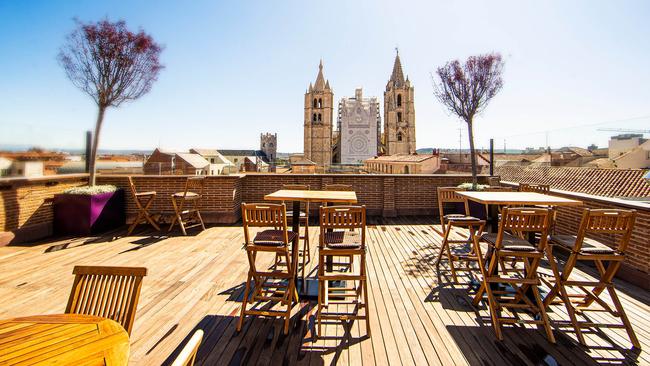Cheat’s guide to doing the 500km Camino pilgrimage in comfort
If the serenity of the Spanish countryside is what attracts you to one of the world’s most famous walks, then perhaps you might like to do the pilgrimage via rail.

In the 9th century, King Alfonso II of Asturias received a letter from a bishop in Galicia. The note explained that the strange glow seen in a local wood was coming from a grave containing the remains of St James. “You’d better come quick,” is possibly how the letter ended. Alfonso came, saw and pondered. The site had enormous business potential. Putting St James’s tomb on the tourist map would provide a safer alternative to Jerusalem for European pilgrims. Towns and cities along the way would benefit from visitor spend, especially if they invested in religious attractions. Alfonso had not only become the first pilgrim to visit the tomb. He’d conceived Europe’s first tourist trail.
Thirteen centuries later, the Camino de Santiago is more popular than ever. So far this year more than 435,000 pilgrims have hobbled into Praza do Obradoiro in Santiago de Compostela and, speaking as one who has limped three times into that square having completed it, a pilgrim is not a pretty sight. Feet swollen, skin burnt and personal hygiene compromised, they bring such a fetid atmosphere to the cathedral that the clergy swing the gigantic incense-filled botafumeiro for exactly the same reason you fumigate a teenager’s bedroom with Glen 20.
And for all that effort, there’s little extrinsic gratification. The trails are crowded, getting a bed is a competitive sport, and the plenary indulgence – basically a Get Out of Hell Free card – is only awarded in jubilee years, the next of which is 2027.


So consider an easier way: a nine-night journey by rail through the cities of the Camino, spending two nights in each. For those on foot, Bilbao, Burgos, Leon and Monforte de Lemos are merely places to wash, eat and sleep. For those on the rails, they’re slow-paced wonders of wine and revelation.
For me – possibly holier than thou – the journey begins in Norfolk, travelling by rail to Portsmouth to board Brittany Ferries’ MS Galicia for a two-night crossing of the Bay of Biscay to Bilbao. Top deck in the sunshine feels more like a cruise and while it’s not cheap (£461/$882 return for a foot passenger booked long in advance compared with £51 by air on Spanish low-cost airline Vueling), it’s a low-carbon pleasure worth paying for.

Bilbao is an outlier on the Camino; a city defined by fire and brimstone before its resurrection as a temple of the arts and dining. Following the extraordinarily detailed step-by-step guide provided by British tour operator Inntravel, I look down on the city from Artxanda Park, pop into the Guggenheim, and spend quality time at the Museo de Bellas Artes. Here, Dario de Regoyos’s Vendredi Saint en Castille shows a procession of penitents passing beneath the railway bridge at Pancorbo, just south of Bilbao, as a train rushes overhead. Choose the hard way or the railway, it seems to suggest.

I’ve picked the latter, boarding the 12.15 to Miranda de Ebro. The train clatters up the Nervion valley, climbing higher and higher through a desert landscape. Goats hide in the shade of oaks and sunflowers are turned away from the sun as though they’ve seen too much. As we speed through the Pancorbo defile I see no penitents. Not in that heat.
At Miranda de Ebro, the city sweltering and silent, I catch the AVE. Spain started building its high-speed lines 30 years ago and now has more than 3200km of track; it’s the most extensive national network after China. A window seat on the 350km/h S112 “Pato’’ trains – so called because of their duck-like profile – offers a million glimpses into the lives of others; to see what they cherish, whether they wash their colours with their whites, and the lie of their land. It’s travel for those who understand that getting there is most of the fun.
Late afternoon brings Burgos, 853m up on the Castilian Meseta and shimmering alongside the knee-deep Rio Arlanzon. There’s an altiplano feel to this conservative Catholic city – the former home of Francisco Franco – but when you see the cathedral it takes you to an even higher place. Conceived by 13th-century German architect Juan de Colonia and more than 500 years in the building, the Catedral Metropolitana de Santa Maria de Burgos is geological in scale and obsessive compulsive in its ornamentation.

My room in the Crisol Meson El Cid hotel faces the Portal de Santa Maria, the view so enormous, so immediate, that when I lie on my bed all I can see is carved stone. Birds, beasts, monsters and men cling to every ledge of the edifice like those chosen to survive a cataclysmic flood.
But for all that, the interior is an exercise in human vanity, where powerful bishops spent their earthly hours overseeing the construction of spectacular chapels dedicated to their own egos. There is, however, one true hero here: Burgos boy Rodrigo Diaz de Vivar, aka El Cid, is buried beneath the dome, at the centre of the transept, at what was once the heart of Spain.
Next stop, Leon: five days on foot and two hours by AVE. It’s ruled by the breakaway Union del Pueblo Leones, so there’s a strong streak of independence here, along with a tapas-fuelled night-life, scattered in a medina-like maze of plazas and alleyways between the Barrio Romantico and the Barrio Humedo.

I start with a tinto de verano, a wine-based cocktail, and widescreen views of the cathedral from the roof terrace of the Camarote Hotel, and then graze the night away: tortilla in El Grillo, morcilla (black pudding) at La Bicha and sopa de ajo (garlic soup) at El Gaucho, the king of the old town bars. Outside the city walls, where few tourists go, there’s treasure too: Cenador Rua Nova, Ferecor and Delirios y Tapas won gold, silver and bronze in Leon’s annual tapa of the year contest.
But back to the cathedral. A shameless copy of Notre Dame de Reims in France, La Pulchra Leonina, or “The Beautiful Leonese”, as this marvel is known, is a triumph of faith over reality that’s built from poor stone, on soggy ground, with its twin towers raised on a wing and a prayer. It was commissioned by a king who fancied himself as an emperor for a provincial city that fancied itself as the imperial capital. Neither came to pass.
The messaging here will make your head spin: its apogee in the central portico where St James welcomes visitors while a gothic horror depiction of the last judgment shows terror-stricken sinners dragged hellbound by monsters as Jesus looks on, his hands raised as though to say “computer says no”.
But it’s the light you’ll remember most – 1765 sq m of stained glass floods the interior with colours so psychedelic they can induce a trance-like state. Come in the morning or late afternoon to experience the sensation at its most intense.
From Leon I take the fast track into Galicia. As the AVE flies towards the setting sun, Spain is replaced by a fairytale world of deep canyons, dense forests and white water. Crepuscular rays light up tiny vineyards in vertiginous clearings; these are the birthplace of the vinos heroicos of the Ribeira Sacra, so called for the effort and courage demanded by their cultivation.
That night I have a bottle from the Rio Sil with my dinner of roasted kid, served in the 17th-century hilltop Parador de Monforte de Lemos. Legend has it that this former monastery was connected to the castle next door by a secret tunnel. It’s said that when the Count of Monforte was off fighting the Moors he left his daughter in the care of the abbot. When the count learnt of the all-too-predictable affair, he invited the monk to the castle, wined him, dined him and served up a harsh but just dessert of a red hot crown, dropped on his tonsured head. They serve a similarly flaming pudding in the parador’s refectory, but they call it crepe suzette.

The following evening I roll into Santiago de Compostela and meet fragrant pilgrims walking out of town. They are the peregrinos inversos I’ve heard about: pilgrims who start at the end and work backwards. “You’ll understand why when you see the old city,” they warn.
And I do. Since my last visit in 2016, this sacred city of rain-shiny streets and musty religious bookshops has sold its soul for mass tourism. The free tapas have gone, along with the bars that gave them away, replaced by tourist restaurants playing smooth jazz.
I wander past endless souvenir shops in search of the old haunts, ending up like a lost soul in the woods of Parque de Alameda, on a hill overlooking the cathedral. It was here where some believe St James was once buried and where modern pilgrims, arriving by trail or rail, can still find a little peace. But if St James could see what’s become of his shrine – and they hadn’t disinterred him – he’d be turning in his grave.


In the know
Inntravel has a nine-night Journey along the Camino de Santiago itinerary, from Bilbao to Santiago de Compostela by train. Available April to November; from £1105 ($2120) a person; includes train travel, daily breakfast, one dinner, accommodation at three to four-star hotels and detailed walking notes. International flights extra.
Abercrombie & Kent offers a 10-day chartered cruise from London to Lisbon, Portugal, that calls at Bilbao and Santiago de Compostela. In the latter city, passengers can visit the cathedral and old town, or walk to Cape Finisterre, the last stop on the Camino. Departs September 21, 2024; from $19,220 a person, twin-share.
Chris Haslam was a guest of Inntravel.
THE TIMES





To join the conversation, please log in. Don't have an account? Register
Join the conversation, you are commenting as Logout